|
|
The Hieromartyr Simeon, Bishop in Persia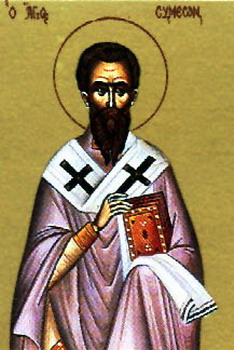 In the time of the wicked King Savori, or Sapor, Simeon was tortured for Christ together with two of his priests, Audel and Ananias. The King's eunuch, Ustazan, who had first denied Christ but then, moved by the reprimand of St Simeon, again confessed the true Faith before the King, was executed before they were. A thousand other Christians were also led to execution with St Simeon, who purposely stood a little back so that he should be the last to die, and so be able to encourage the other Christians right to the end and keep them from wavering through fear of death. When the priest Ananias laid his head on the block, he was trembling all over. But the King's clerk, Fusik, who was himself secretly a Christian, began to encourage him, saying: 'Don't be frightened, old man. Shut your eyes and be a man, and you'll see the divine light.' As soon as he had said this, it was seen that he was a Christian and he was denounced to the King. The King wore him down with harsh tortures, and also his daughter, the maiden Askitria. St Simeon was eventually beheaded, after having seen his flock into the other world. The following year, on Great Friday, the King's beloved eunuch, Azat, was slain for Christ, along with another thousand of the faithful. Then the King grieved for his eunuch and gave up killing any more Christians. They all suffered with honour for Christ their King and Lord in about 341. In the time of the wicked King Savori, or Sapor, Simeon was tortured for Christ together with two of his priests, Audel and Ananias. The King's eunuch, Ustazan, who had first denied Christ but then, moved by the reprimand of St Simeon, again confessed the true Faith before the King, was executed before they were. A thousand other Christians were also led to execution with St Simeon, who purposely stood a little back so that he should be the last to die, and so be able to encourage the other Christians right to the end and keep them from wavering through fear of death. When the priest Ananias laid his head on the block, he was trembling all over. But the King's clerk, Fusik, who was himself secretly a Christian, began to encourage him, saying: 'Don't be frightened, old man. Shut your eyes and be a man, and you'll see the divine light.' As soon as he had said this, it was seen that he was a Christian and he was denounced to the King. The King wore him down with harsh tortures, and also his daughter, the maiden Askitria. St Simeon was eventually beheaded, after having seen his flock into the other world. The following year, on Great Friday, the King's beloved eunuch, Azat, was slain for Christ, along with another thousand of the faithful. Then the King grieved for his eunuch and gave up killing any more Christians. They all suffered with honour for Christ their King and Lord in about 341.St Acacius, Bishop of Melitene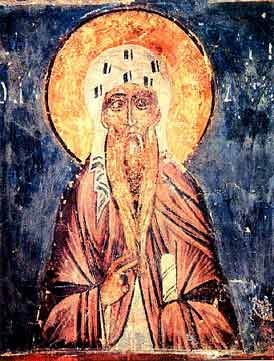 He lived in asceticism in his birthplace, the city of Melitene in Armenia. Blessed Otreius, the bishop of that city, who took part in the Second Ecumenical Council in 381, ordained him to the priesthood. After Otreius' death, Acacius was chosen as bishop. He participated in the Third Ecumenical Council in 431, which condemned the Nestorian blasphemy concerning the Mother of God. There he, together with St Cyril of Alexandria, showed great zeal for the purity of the Orthodox faith. St Acacius was endowed with great grace by God, and worked many miracles. After long and zealous service of God, he died peacefully in 435. He lived in asceticism in his birthplace, the city of Melitene in Armenia. Blessed Otreius, the bishop of that city, who took part in the Second Ecumenical Council in 381, ordained him to the priesthood. After Otreius' death, Acacius was chosen as bishop. He participated in the Third Ecumenical Council in 431, which condemned the Nestorian blasphemy concerning the Mother of God. There he, together with St Cyril of Alexandria, showed great zeal for the purity of the Orthodox faith. St Acacius was endowed with great grace by God, and worked many miracles. After long and zealous service of God, he died peacefully in 435.St Agapetus (Agapitus), Pope of Rome He was sent by Theodotus, King of the Goths, to the Emperor Justinian in Constantinople, to dissuade the latter from his campaign against the Goths. On the way, he healed a dumb and blind man. In Constantinople, he helped to uphold Orthodoxy, and died in 536. He was sent by Theodotus, King of the Goths, to the Emperor Justinian in Constantinople, to dissuade the latter from his campaign against the Goths. On the way, he healed a dumb and blind man. In Constantinople, he helped to uphold Orthodoxy, and died in 536.Our Holy Fathers Sabbatius and Zossima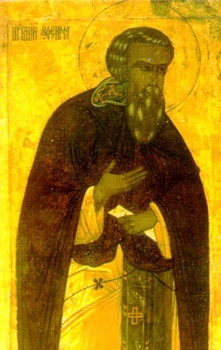 These two were the founders of an ascetic community on the island of Solovetz in the White Sea. Many great saints were glorified in this community. St Sabbatius entered into rest in 1435, and St Zossima in 1478. These two were the founders of an ascetic community on the island of Solovetz in the White Sea. Many great saints were glorified in this community. St Sabbatius entered into rest in 1435, and St Zossima in 1478.Martyr Adrian of Corinth (151)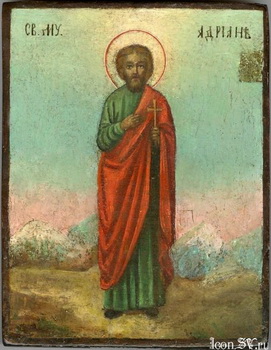 The Holy Martyr Adrian suffered during the time of the reign of the emperor Decius (249-251). They had locked him up in prison. During the time of a pagan feast they brought out all the imprisoned Christians so that they should offer sacrifice to the idols. They ordered Saint Adrian to throw on the sacrifice some aromatic resin. But the holy martyr rushed at the laid-out sacrificial offering, scattered the fire and wrecked the sacrifice. The pagans in a rage flung themselves upon him, beating at him with canes and iron rods, striking at him with stones, and they then threw him into a red-hot fire (+ 251). The Holy Martyr Adrian suffered during the time of the reign of the emperor Decius (249-251). They had locked him up in prison. During the time of a pagan feast they brought out all the imprisoned Christians so that they should offer sacrifice to the idols. They ordered Saint Adrian to throw on the sacrifice some aromatic resin. But the holy martyr rushed at the laid-out sacrificial offering, scattered the fire and wrecked the sacrifice. The pagans in a rage flung themselves upon him, beating at him with canes and iron rods, striking at him with stones, and they then threw him into a red-hot fire (+ 251).Martyrs Abdechalas and Ananias presbyters, Usthazanes, Fusicus (Pusicius), Ascitrea, and Azat the Eunuch (341)Venerable Zosimas of Solovki (1478)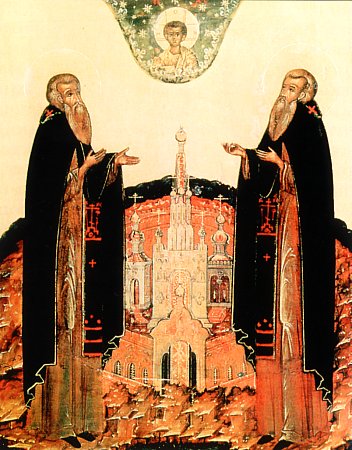 The Monk Zosima, Hegumen of Solovetsk, – a great luminary of the Russian North, was the founder of monastic common-life on Solovetsk Island. He was born in Novgorod diocese, in the village of Tolvui near Lake Onega. From his early years he was raised in piety, and after the death of his parents Gavriil and Varvara he gave away his possessions and accepted monastic tonsure.
In search of a solitary place the monk set off to the shores of the White Sea and at the mouth of the Suma he met the Monk German (Comm. 30 July), who told him about a desolate sea island, where formerly he had spent six years with the Monk Savvatii (Comm. 27 September).
In about the year 1436 the hermits, felicitously having made the sea voyage, landed at the Solovetsk islands. God blessed the place of their settlement with a vision to the Monk Zosima of a beautiful church in the sky. The monks with their own hands built cells and an enclosure, and they began to cultivate and sow the land. One time in late Autumn the Monk German set off to the mainland for necessary provisions. Because of the Autumn weather he was not able to return. The Monk Zosima remained all Winter alone on the island. He suffered many a temptation in struggle with the devils. Death by starvation threatened him, but miraculously two strangers having appeared left him a supply of bread, flour and oil. In Spring the Monk German returned to Solovetsk together with the fisherman Mark, and he brought supplies of food and rigging-tackle for fish nets.
When several hermits had gathered on the island, the Monk Zosima constructed for them a small wooden church in honour of the Transfiguration (Preobrazhenie) of the Lord, together with a refectory. At the request of the Monk Zosima, an hegumen was sent from Novgorod to the newly formed monastery with antimins for the church. Thus occurred the start of the reknown Solovetsk monastery. In the severe conditions of the remote island the monks knew how to arrange their economy. But the hegumens, sent from Novgorod to Solovetsk, could not withstand life in the unwontedly harsh conditions, and so the brethren chose as hegumen the Monk Zosima.
The Monk Zosima concerned himself with the building up of the inner life of the monastery, and he introduced a strict life-in-common. In 1465 he transferred to Solovetsk from the River Vyg the relics of the Monk Savvatii. The monastery suffered vexation from the Novgorod boyars (nobles), who confiscated catches of fish from the monks. The monk was obliged to set off for Novgorod and seek the protection of the archbishop. On the advice of the archbishop, he made the rounds of homes of the boyars and requested them not to allow the ruin of the monastery. The influential and rich boyarina Martha Boretskaya impiously gave orders to throw out the Monk Zosima, but then repented her action and invited him to a meal, during the time of which he suddenly beheld, that six of the illustrious boyars sat without their heads. The Monk Zosima told about this vision to his disciple Daniel and predicted for the boyars an immanent death. The prediction was fulfilled in the year 1478, when during the taking of Novgorod by Ivan III (1462-1505) the boyars were executed.
Shortly before death the monk prepared himself a grave, in which he was buried beyond the altar of the Transfiguration church (+ 17 April 1478). Later on, over his relics was built a chapel. His relics together with the relics of the Monk Savvatii were transferred on 8 August 1566 into a chapel consecrated in their memory at the Transfiguration cathedral.
Many a miracle was witnessed to, when the Monk Zosima with the Monk Savvatii appeared to fishermen perishing in the depths of the sea. The Monk Zosima is likewise a patron of bee-keeping and preserver of bee-hives, and to him is even bestown the title "Bee-keeper" ("Pchel'nik"). To the Monk Zosima often hasten those in sickness. The many hospital churches dedicated to him testify to the great curative power of his prayer before God. The Monk Zosima, Hegumen of Solovetsk, – a great luminary of the Russian North, was the founder of monastic common-life on Solovetsk Island. He was born in Novgorod diocese, in the village of Tolvui near Lake Onega. From his early years he was raised in piety, and after the death of his parents Gavriil and Varvara he gave away his possessions and accepted monastic tonsure.
In search of a solitary place the monk set off to the shores of the White Sea and at the mouth of the Suma he met the Monk German (Comm. 30 July), who told him about a desolate sea island, where formerly he had spent six years with the Monk Savvatii (Comm. 27 September).
In about the year 1436 the hermits, felicitously having made the sea voyage, landed at the Solovetsk islands. God blessed the place of their settlement with a vision to the Monk Zosima of a beautiful church in the sky. The monks with their own hands built cells and an enclosure, and they began to cultivate and sow the land. One time in late Autumn the Monk German set off to the mainland for necessary provisions. Because of the Autumn weather he was not able to return. The Monk Zosima remained all Winter alone on the island. He suffered many a temptation in struggle with the devils. Death by starvation threatened him, but miraculously two strangers having appeared left him a supply of bread, flour and oil. In Spring the Monk German returned to Solovetsk together with the fisherman Mark, and he brought supplies of food and rigging-tackle for fish nets.
When several hermits had gathered on the island, the Monk Zosima constructed for them a small wooden church in honour of the Transfiguration (Preobrazhenie) of the Lord, together with a refectory. At the request of the Monk Zosima, an hegumen was sent from Novgorod to the newly formed monastery with antimins for the church. Thus occurred the start of the reknown Solovetsk monastery. In the severe conditions of the remote island the monks knew how to arrange their economy. But the hegumens, sent from Novgorod to Solovetsk, could not withstand life in the unwontedly harsh conditions, and so the brethren chose as hegumen the Monk Zosima.
The Monk Zosima concerned himself with the building up of the inner life of the monastery, and he introduced a strict life-in-common. In 1465 he transferred to Solovetsk from the River Vyg the relics of the Monk Savvatii. The monastery suffered vexation from the Novgorod boyars (nobles), who confiscated catches of fish from the monks. The monk was obliged to set off for Novgorod and seek the protection of the archbishop. On the advice of the archbishop, he made the rounds of homes of the boyars and requested them not to allow the ruin of the monastery. The influential and rich boyarina Martha Boretskaya impiously gave orders to throw out the Monk Zosima, but then repented her action and invited him to a meal, during the time of which he suddenly beheld, that six of the illustrious boyars sat without their heads. The Monk Zosima told about this vision to his disciple Daniel and predicted for the boyars an immanent death. The prediction was fulfilled in the year 1478, when during the taking of Novgorod by Ivan III (1462-1505) the boyars were executed.
Shortly before death the monk prepared himself a grave, in which he was buried beyond the altar of the Transfiguration church (+ 17 April 1478). Later on, over his relics was built a chapel. His relics together with the relics of the Monk Savvatii were transferred on 8 August 1566 into a chapel consecrated in their memory at the Transfiguration cathedral.
Many a miracle was witnessed to, when the Monk Zosima with the Monk Savvatii appeared to fishermen perishing in the depths of the sea. The Monk Zosima is likewise a patron of bee-keeping and preserver of bee-hives, and to him is even bestown the title "Bee-keeper" ("Pchel'nik"). To the Monk Zosima often hasten those in sickness. The many hospital churches dedicated to him testify to the great curative power of his prayer before God. Venerable Macarius of Corinth (1805)
|